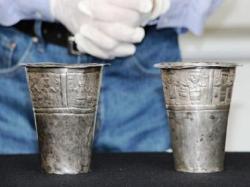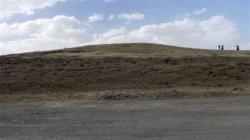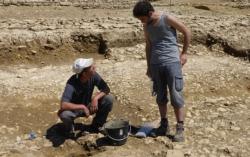INSTITUT SUPERIEUR D'ANTHROPOLOGIE
INSTITUTE OF ANTHROPOLOGY
ONLINE COURSES / COURS A DISTANCE
FALL TERM : OCTOBER 2015
REGISTER NOW
PEROU –  Purunilacta de Soloco - They might not be as sacred as the Holy Grail, but two metal vessels recently discovered in Chachapoyas are turning heads in regards to understanding the region’s ancient history. “The Finding of these vessels will change the story about Chachapoyas” the Decentralized Department of Culture of the Amazonas head, Jose Santos Trauco Ramos, told El Comercio. The discovery of two silver vessels in the Soloco Purunllacta in Chachapoyas of the Amazonas department are unlike anything the archaeological team has found in its history. Investigations until this date had never discussed the peoples of Chachapoyas involved in metalworks, reports El Comercio. The two vessels have recently finished a 60 restoration period at the conservation area of the Museo Arqueologico Nacional Bruning of Lambayeque. Trauco says it is too early to be sure, but there is a possibility that the vessels with Inca influence, could have been offerings. The vessels weigh 152 grams each, 112 millimeters high and 117 millimeters in diameter. They will be part of an exhibition on the grounds of what will soon be the Museum of Chachapoyas. Chachapoyas is one of Peru’s most sacred archaeological zones. However, its isolation and difficult to reach location, make it less popular and less visited. Kuelap is one of the most impressive sites, located 3,000 meters above sea level, the site is a must when in Chachapoyas.
Purunilacta de Soloco - They might not be as sacred as the Holy Grail, but two metal vessels recently discovered in Chachapoyas are turning heads in regards to understanding the region’s ancient history. “The Finding of these vessels will change the story about Chachapoyas” the Decentralized Department of Culture of the Amazonas head, Jose Santos Trauco Ramos, told El Comercio. The discovery of two silver vessels in the Soloco Purunllacta in Chachapoyas of the Amazonas department are unlike anything the archaeological team has found in its history. Investigations until this date had never discussed the peoples of Chachapoyas involved in metalworks, reports El Comercio. The two vessels have recently finished a 60 restoration period at the conservation area of the Museo Arqueologico Nacional Bruning of Lambayeque. Trauco says it is too early to be sure, but there is a possibility that the vessels with Inca influence, could have been offerings. The vessels weigh 152 grams each, 112 millimeters high and 117 millimeters in diameter. They will be part of an exhibition on the grounds of what will soon be the Museum of Chachapoyas. Chachapoyas is one of Peru’s most sacred archaeological zones. However, its isolation and difficult to reach location, make it less popular and less visited. Kuelap is one of the most impressive sites, located 3,000 meters above sea level, the site is a must when in Chachapoyas.
http://www.peruthisweek.com/news-discovery-of-metal-vessels-will-change-the-history-of-chachapoyas-106778
SYRIE –  Palmyre - Le groupe Etat islamique a commencé la destruction de la cité antique de Palmyre (Syrie). Tombé aux mains du groupe terroriste il y a un mois, le site est truffé d’explosifs. Ces derniers jours deux anciens mausolées islamiques ont été détruits, selon des photos relayées sur Internet. Dimanche 21 juin, le mausolée de Muhammad Ali a été détruit, a affirmé le directeur des antiquités syriennes Maamoun Abdel Karim. Le site était situé à quatre kilomètres au nord de Palmyre. Sur Internet, des photos montrent deux hommes armés, à côté du mausolée, portant des bombonnes d’explosifs. Selon la même source, un mausolée de Chkaf, datant de plus de 500 ans, a également été détruit par Daesh.
Palmyre - Le groupe Etat islamique a commencé la destruction de la cité antique de Palmyre (Syrie). Tombé aux mains du groupe terroriste il y a un mois, le site est truffé d’explosifs. Ces derniers jours deux anciens mausolées islamiques ont été détruits, selon des photos relayées sur Internet. Dimanche 21 juin, le mausolée de Muhammad Ali a été détruit, a affirmé le directeur des antiquités syriennes Maamoun Abdel Karim. Le site était situé à quatre kilomètres au nord de Palmyre. Sur Internet, des photos montrent deux hommes armés, à côté du mausolée, portant des bombonnes d’explosifs. Selon la même source, un mausolée de Chkaf, datant de plus de 500 ans, a également été détruit par Daesh.
https://fr.news.yahoo.com/palmyre-daesh-commence-la-destruction-de-la-cite-antique-172638442.html
JAPON –  Kyoto - Parts of stone walls and gold-plated roof tiles believed to be the ruins of Shigetsu Castle have been discovered at the construction site for a new apartment complex in Fushimi Ward, Kyoto, a private research firm has announced. Feudal leader Toyotomi Hideyoshi began construction on the castle in 1592, a year after he ended his regency. But it was called a “phantom castle” because it was said to have been destroyed by an earthquake in 1596, and no remnants had ever been found. Researchers have excavated some 36 meters of stone wall about 0.5 to 1 meter high and 2 meters thick, more than 100 fragments of gold-plated roof tiles, and the remains of a 5- to 7-meter-wide, 2-meter-deep moat, according to Kyoto-based firm Kyoto Heian Bunkazai. “I was very surprised because we believed the stone walls of Shigetsu Castle had collapsed and had been totally lost,” said Nara University President Yoshihiro Senda, who is an expert on the archaeology of castle sites. “The long stone walls found this time show that the castle was large and luxurious, and we can easily imagine the great power of Hideyoshi.” The wall was built by piling up large square-shaped stones measuring more than a meter on each side and filling the cracks with smaller stones, similar to the method used to build the stone walls around Jurakudai, a lavish palace built in Kyoto earlier at Hideyoshi’s order. The gold roof tiles had patterns similar to those used in Osaka Castle, which was also built under Hideyoshi’s rule. “The fact that the location of the castle was made clear is a significant discovery,” said professor Hitoshi Nakai of the University of Shiga Prefecture. “The remains show the characteristics of construction ordered by Hideyoshi, who had a great influence on castle-building in Japan.” After Shigetsu Castle collapsed, a new one called Fushimi Castle was constructed nearby and became the place where Hideyoshi died in 1598.
Kyoto - Parts of stone walls and gold-plated roof tiles believed to be the ruins of Shigetsu Castle have been discovered at the construction site for a new apartment complex in Fushimi Ward, Kyoto, a private research firm has announced. Feudal leader Toyotomi Hideyoshi began construction on the castle in 1592, a year after he ended his regency. But it was called a “phantom castle” because it was said to have been destroyed by an earthquake in 1596, and no remnants had ever been found. Researchers have excavated some 36 meters of stone wall about 0.5 to 1 meter high and 2 meters thick, more than 100 fragments of gold-plated roof tiles, and the remains of a 5- to 7-meter-wide, 2-meter-deep moat, according to Kyoto-based firm Kyoto Heian Bunkazai. “I was very surprised because we believed the stone walls of Shigetsu Castle had collapsed and had been totally lost,” said Nara University President Yoshihiro Senda, who is an expert on the archaeology of castle sites. “The long stone walls found this time show that the castle was large and luxurious, and we can easily imagine the great power of Hideyoshi.” The wall was built by piling up large square-shaped stones measuring more than a meter on each side and filling the cracks with smaller stones, similar to the method used to build the stone walls around Jurakudai, a lavish palace built in Kyoto earlier at Hideyoshi’s order. The gold roof tiles had patterns similar to those used in Osaka Castle, which was also built under Hideyoshi’s rule. “The fact that the location of the castle was made clear is a significant discovery,” said professor Hitoshi Nakai of the University of Shiga Prefecture. “The remains show the characteristics of construction ordered by Hideyoshi, who had a great influence on castle-building in Japan.” After Shigetsu Castle collapsed, a new one called Fushimi Castle was constructed nearby and became the place where Hideyoshi died in 1598.
http://www.japantimes.co.jp/news/2015/06/19/national/history/kyoto-construction-site-yields-apparent-ruins-hideyoshis-shigetsu-castle/#.VYms2N-c08r
CANADA – Rim - A mysterious, "large" face on the cliffside of an island in the Pacific Rim National Park Reserve has recently been re-discovered by a man who has been searching for the face for over two years, according to government agency Parks Canada. Hank Gus of the Tseshaht First Nation, an aboriginal group in the area, first heard about the “face in the rocks” of Reeks Island, part of the Broken Group Islands, from a kayaking tourist in 2008, said Parks Canada First Nation’s program manager Matthew Payne. “Gus and some Tseshaht beach keepers recently discovered it a few weeks ago, and they were very excited to share it with us and the archaeologist we work with,” Payne, 43, told ABC News Tuesday. “We went out to see it recently, and it’s remarkable. It really is a face staring back at you.” The face, believed to be about 7 feet tall, is similar to a wooden carving on the door of the Tseshaht administration office, Payne said. “The Tseshaht has lived in area for thousands of years, so we working with the First Nations to find out if there are any oral histories the face could link back to,” Payne added. Now, Tseshaht First Nation and Parks Canada are trying to figure out if the face was man-made or if it's a natural marvel, he said. “Mother Nature is capable of creating all sorts of amazing things, though the face is very striking," Payne said. "But we still can’t definitively say if the face is man-made or not." Though the Tseshaht and Parks Canada would like to examine the face up-close, the cliff the face is on is treacherous, Payne said.
VIDEO = http://abcnews.go.com/International/man-discovers-mysterious-large-face-canada-cliffside-year/story?id=31968181
IRAN –  Selseleh - Demarcation operation started in Kartabad hill in Selseleh township, Lorestan province, highlighting potentials for findings from the copper, stone age and early Islamic eras, said Nastaran Davoodi, the project manager. "This was done to determine the precincts of the historical site in order to preserve the archeological remains," said Davoodi, noting illegal constructions to the west of the location along with an asphalted road have posed risks to the site. Davoodi said there is also evidence of human settlements at the site. The demarcation process, which started last month, will continue until July. 10.
Selseleh - Demarcation operation started in Kartabad hill in Selseleh township, Lorestan province, highlighting potentials for findings from the copper, stone age and early Islamic eras, said Nastaran Davoodi, the project manager. "This was done to determine the precincts of the historical site in order to preserve the archeological remains," said Davoodi, noting illegal constructions to the west of the location along with an asphalted road have posed risks to the site. Davoodi said there is also evidence of human settlements at the site. The demarcation process, which started last month, will continue until July. 10.
http://www.iran-daily.com/News/120729.html?
ROYAUME UNI –  Clacton - A Stone Age axe head that could date back more than 200,000 years has been discovered on a beach near Clacton. Neighbours Mary Gilbert and Rodney Lee found the hand-sized tool in shingle near the low tide mark at Holland Haven. Rodney said the prehistoric tool was in such good condition, it could not have been on the beach for long because it would have been worn smooth by pebbles. Clacton has a rich Stone Age heritage and even gives its name to primitive Clactonian tools, made by striking flakes from a piece of flint thousands of years ago.
Clacton - A Stone Age axe head that could date back more than 200,000 years has been discovered on a beach near Clacton. Neighbours Mary Gilbert and Rodney Lee found the hand-sized tool in shingle near the low tide mark at Holland Haven. Rodney said the prehistoric tool was in such good condition, it could not have been on the beach for long because it would have been worn smooth by pebbles. Clacton has a rich Stone Age heritage and even gives its name to primitive Clactonian tools, made by striking flakes from a piece of flint thousands of years ago.
http://www.clactonandfrintongazette.co.uk/news/13347854._/?
FRANCE –  Alise-Sainte-Reine - Une quarantaine d’universitaires, doctorants ou étudiants en archéologie ont participé à la campagne de fouilles 2015 qui s’est terminée samedi. L’existence d’un quartier religieux autour d’un temple dédié à Apollon Moritasgus à proximité de l’oppidum, à la Croix-Saint-Charles, est désormais acquise : c’est l’une des conclusions à laquelle a abouti la huitième campagne de fouilles, conduite par Olivier de Cazanove, professeur en archéologie à l’université de la Sorbonne-Paris 1, qui s’est terminée le 20 juin. Après cinq semaines de fouilles sur les 1 900 m², l’équipe internationale d’une quarantaine d’universitaires, doctorants ou étudiants en archéologie s’est attachée à vérifier tout ce qui avait été écrit ou dit sur le site. Le temple, qui dispose d’une architecture complexe, a livré au cours de cette campagne des plaquettes qui forment un ensemble de plus de trois cents ex-voto gallo-romains, vraisemblablement fixés sur le mur de péribole (de clôture) du sanctuaire et dont les chaperons sont tombés au sol par la suite. « Tout autour, dans les fossés datant de l’époque gauloise - avant le siège d’Alésia en 52 avant notre ère -, nous avons trouvé un grand nombre de fragments de céramique d’amphores italiques et d’os d’animaux (caprins, ovins…) qui nous laissent penser qu’il s’agit de reliefs de festins (les débris d’ossements sont analysés par Patrice Meniel, directeur de recherches au CNRS). L’ensemble a ensuite disparu sous une cinquantaine de mètres de chaussée recouverte par des petits galets puis par le sanctuaire gallo-romain. » De plus, la découverte d’un réseau de canalisations et de bassins confirme la spécificité de ce sanctuaire des eaux. « Ces fouilles nous permettent de reconstituer les différentes phases de construction », explique le doctorant Jonathan Vidal, sur le site des thermes sis en contrebas du temple. L’eau a servi pour le culte religieux d’abord au temple sur les hauteurs, puis pour simplement alimenter de manière profane et pratique les canalisations des thermes publiques, en contrebas. Ailleurs, sur le site, plusieurs cavités et bassins démontrent l’existence d’un réseau de captage susceptible d’être en relation avec l’ancienne Fontaine de la Porte.
Alise-Sainte-Reine - Une quarantaine d’universitaires, doctorants ou étudiants en archéologie ont participé à la campagne de fouilles 2015 qui s’est terminée samedi. L’existence d’un quartier religieux autour d’un temple dédié à Apollon Moritasgus à proximité de l’oppidum, à la Croix-Saint-Charles, est désormais acquise : c’est l’une des conclusions à laquelle a abouti la huitième campagne de fouilles, conduite par Olivier de Cazanove, professeur en archéologie à l’université de la Sorbonne-Paris 1, qui s’est terminée le 20 juin. Après cinq semaines de fouilles sur les 1 900 m², l’équipe internationale d’une quarantaine d’universitaires, doctorants ou étudiants en archéologie s’est attachée à vérifier tout ce qui avait été écrit ou dit sur le site. Le temple, qui dispose d’une architecture complexe, a livré au cours de cette campagne des plaquettes qui forment un ensemble de plus de trois cents ex-voto gallo-romains, vraisemblablement fixés sur le mur de péribole (de clôture) du sanctuaire et dont les chaperons sont tombés au sol par la suite. « Tout autour, dans les fossés datant de l’époque gauloise - avant le siège d’Alésia en 52 avant notre ère -, nous avons trouvé un grand nombre de fragments de céramique d’amphores italiques et d’os d’animaux (caprins, ovins…) qui nous laissent penser qu’il s’agit de reliefs de festins (les débris d’ossements sont analysés par Patrice Meniel, directeur de recherches au CNRS). L’ensemble a ensuite disparu sous une cinquantaine de mètres de chaussée recouverte par des petits galets puis par le sanctuaire gallo-romain. » De plus, la découverte d’un réseau de canalisations et de bassins confirme la spécificité de ce sanctuaire des eaux. « Ces fouilles nous permettent de reconstituer les différentes phases de construction », explique le doctorant Jonathan Vidal, sur le site des thermes sis en contrebas du temple. L’eau a servi pour le culte religieux d’abord au temple sur les hauteurs, puis pour simplement alimenter de manière profane et pratique les canalisations des thermes publiques, en contrebas. Ailleurs, sur le site, plusieurs cavités et bassins démontrent l’existence d’un réseau de captage susceptible d’être en relation avec l’ancienne Fontaine de la Porte.
http://www.bienpublic.com/edition-haute-cote-d-or/2015/06/22/pour-mieux-connaitre-le-passe